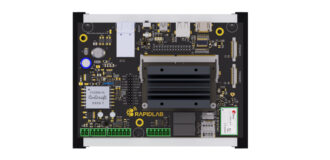19th January 2023

Recently we had the opportunity to work on an interesting geolocation project. The challenge was to locate large objects in a particular and demanding environment. We decided to use RTK (real-time kinematic positioning) GPS technology characterized by high precision. However, the first attempts did not satisfy us. Why? Below you will find an overview of GNSS technology, with a description of the tests we’ve conducted and the RTK GPS sets used.
Move straight to RTK testing in a challenging environment.
GNSS technology
Satellite navigation “global navigation satellite system” (GNSS) technologies include systems such as GPS, Glonass, Beidou, and QZSS. They determine position based on the distance between the satellites and the receiver. This is made possible by calculations relating to the path the signal travels. This path is being determined by time – the difference between the moment of transmission and reception multiplied by the speed of the signal. The receiver estimates the path crossed by the signal, which is the distance of interest to the receiver from the satellite.
Knowing the receiver’s distance from several satellites, we can use triangulation to determine its position. However, it turns out that the calculated distance is different from the real one due to errors affecting the accuracy of the data. The most significant for our readings are three errors: orbit, clock, and troposphere.
Environmental conditions
Under ideal conditions for GPS operation, we enjoy an open sky and a good horizon view, with no terrain obstructions. The antenna allows us to receive signals up to about 150°.
Any terrain obstruction between the satellite and the receiver decreases the system’s accuracy. This is different from the inability to use satellite navigation technology as long as the obstacles do not obscure the entire range of sky visibility, only part of it. In this case, one benefits from the availability of a limited number of satellites. The minimum theoretical number of satellites that allows the correct position calculation is four. Of course, a more significant number of satellites means a more accurate and stable location reading. The more urbanized the environment, the worse the conditions for the operation of satellite systems.
Another cause of measurement errors is reflections. This is a situation in which the signal reaches the receiver not only by a direct path but also by a reflected path. Terrain obstacles such as buildings or trees reflect the signal, creating additional pathways for the signal, which introduces interference.
How does RTK GPS get centimeter accuracy?
RTK GPS is a technology characterized by high precision obtained in real-time. However, for satisfactory performance, necessary conditions should be met. RTK determines corrections to the GPS system to offset errors. The basis of operation is the short distance between the end receiver and the reference station. The correct maximum distance between the two stations is up to 10 km. Therefore, the operation of the RTK system will only make sense in the local area. For example, parameters calculated in the center of London have no value in Glasgow.
Corrections are made at a base station with a known reference position. The GPS receiver of this base station, in addition to knowing the said reference position, also receives a satellite signal and, on this basis, collects data, determining its position. Since the base station is in a known place, it can calculate the error for each satellite signal received. Based on the difference between the two locations, corrections are calculated. In the next step, they are distributed to the final receiver, located close to the base station. Then the corrected position is calculated.
Corrections between the base station and the end receiver can be transmitted directly via radio technologies, e.g., Wi-Fi, Lora, or via cellular networks using NTRIP protocols. An alternative solution for acquiring RTK corrections is to use a subscription system, e.g., Precise Perfect Point from Ublox, which makes them available over the Internet using the MQTT protocol. This option allows you to use RTK corrections immediately, without having your own base station, over the entire service area, not just the base station’s operating district. Of course, this entails that the more devices are scaled in the system, the cost of subscription increases.
In comparison – investing in having your own base station has its advantages, but it also generates additional difficulties. By connecting a more significant number of receivers to the base station, we do not incur the extra cost of an increasing subscription. This translates into lower maintenance costs, despite the initial investment in our own equipment. Remember that the base station should be placed in a stable environment with constant power supply and service. The coverage zone can also be a challenge – one station covers an area with a radius of 10 km. For areas exceeding this range, additional base stations are required.
Curious if a GPS system with RTK corrections could solve your problem?
More paths – greater accuracy
Recently, dual-frequency receivers are appearing on the market for L1 and L5 frequencies. An important fact is that waves of different frequencies travel different paths. This is due to, among other things, different angles of refraction at the interface of atmospheric layers. The receiver processes signals from two separate paths and calculates the paths they travel – based on these differences, among other things, the error of the troposphere is corrected. The doubled number of paths increases accuracy in favor of dual-frequency receivers.
Industrial applications for RTK GPS systems
Geodesy
Autonomous machines
Agriculture
Drones
RTK GPS has found applications in a variety of technological fields. The common use of the system is in surveying. For several years, it has also been efficiently implemented in outdoor autonomous machines, horticulture, or precision agriculture, where it is used for precise navigation and parallel driving support. Interesting solutions for RTK GPS can also be seen in the context of precision navigation in drones. This market has great potential due to the variety of tasks these relatively small devices can perform.
How does RTK GPS perform in a challenging environment?
In November 2021, we had the opportunity to work with a company that acted as a solution integrator for its client. As part of the cooperation, we worked on the problem of identifying and locating containers in a container port. Containers are stored in the tower of up to 5 containers. The towers, in turn, are arranged in rows, which creates an unfavorable environment for radio signal propagation by creating multiple radio corridors. This results in a large number of reflected signals and a limited area of sky visibility.
Tests in a container port
In the first tests, we used a single-frequency RTK GPS receiver – Ublox Neo M8P. The base station communicates with the mobile station’s second module via Lora radio technology.
Problems in collecting location data encountered in the container port:
- Lack of adequate visibility on the horizon; covering the visibility of the free field around the receiver by standing containers;
- Reflection of the signal from the metal walls of the containers;
- Failure of the receiver to synchronize with the satellite as a consequence of signal reception problems;
Tests in a container port
In the first tests, we used a single-frequency RTK GPS receiver – Ublox Neo M8P. The base station communicates with the mobile station’s second module via Lora radio technology.
Problems in collecting location data encountered in the container port:
- Lack of adequate visibility on the horizon; covering the visibility of the free field around the receiver by standing containers;
- Reflection of the signal from the metal walls of the containers;
- Failure of the receiver to synchronize with the satellite as a consequence of signal reception problems;
Unfortunately, due to the challenging radio signal propagation environment, we faced a situation in which the selected RTK GPS receiver did not meet our expectations. When the antenna was in an environment of high-stacked containers, there was an obscuring of a significant area of the visible sky. This resulted in the receiver switching to GPS mode without RTK corrections because not enough satellites were being seen. In addition, position drift was noticeable – this had to do with the numerous interferences of the many radio signal reflections.
Tests in urbanized environment
We decided to benchmark tests in an urban environment. We tested how close we could get to office buildings without losing RTK correction support due to insufficient satellites. We used the same Ublox Neo M8P single-frequency RTK set for this. However, we quickly encountered a similar problem as at the container port. An office building obscured some of the satellites, causing the signal to fade, and we lost corrections when approaching a wall at a distance of about 8-10m. Terrain obstacles proved to be a huge problem, even though they were relatively low compared to the container port. Conclusion: a single-frequency set cannot be used for this type of navigation.
We decided to test the Ublox c099-f9p-1 dual-frequency RTK set with the ZED F9P receiver. We reproduced the same test conditions in an urban environment and finally obtained very stable position readings. During the tests, we reduced the distance between the receiver and the building. Despite approaching 1m from the wall, the RTK set worked correctly. There was also no position drift over time, and the GPS receiver’s position reading reflected the actual change in location. The results were very good for our purposes.
The potential of solutions with RTK corrections is clearly visible. In testing with the dual-frequency set in an urban environment, we crossed a boundary that had not been reached before. The accuracy and results suggest that the dual-frequency system is more resilient to sources of reflected signal interference. We are therefore further testing and exploring the knowledge needed to implement RTK systems in production. The next step will be testing in the target environment, which is a container port. Follow our updates!
See also:
Let’s stay in touch
Tell us about your IoT project and we’ll get back to you shortly.
Talk to our expert

Paweł Skiba
IoT Solution Architect




